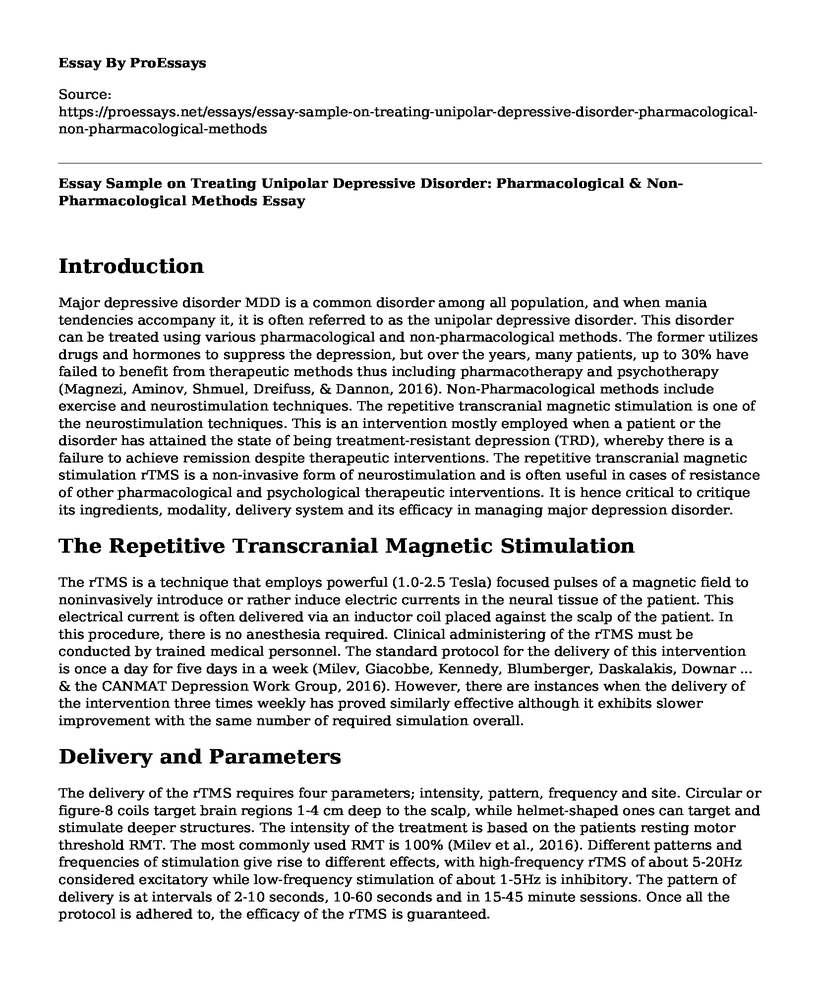Introduction
Major depressive disorder MDD is a common disorder among all population, and when mania tendencies accompany it, it is often referred to as the unipolar depressive disorder. This disorder can be treated using various pharmacological and non-pharmacological methods. The former utilizes drugs and hormones to suppress the depression, but over the years, many patients, up to 30% have failed to benefit from therapeutic methods thus including pharmacotherapy and psychotherapy (Magnezi, Aminov, Shmuel, Dreifuss, & Dannon, 2016). Non-Pharmacological methods include exercise and neurostimulation techniques. The repetitive transcranial magnetic stimulation is one of the neurostimulation techniques. This is an intervention mostly employed when a patient or the disorder has attained the state of being treatment-resistant depression (TRD), whereby there is a failure to achieve remission despite therapeutic interventions. The repetitive transcranial magnetic stimulation rTMS is a non-invasive form of neurostimulation and is often useful in cases of resistance of other pharmacological and psychological therapeutic interventions. It is hence critical to critique its ingredients, modality, delivery system and its efficacy in managing major depression disorder.
The Repetitive Transcranial Magnetic Stimulation
The rTMS is a technique that employs powerful (1.0-2.5 Tesla) focused pulses of a magnetic field to noninvasively introduce or rather induce electric currents in the neural tissue of the patient. This electrical current is often delivered via an inductor coil placed against the scalp of the patient. In this procedure, there is no anesthesia required. Clinical administering of the rTMS must be conducted by trained medical personnel. The standard protocol for the delivery of this intervention is once a day for five days in a week (Milev, Giacobbe, Kennedy, Blumberger, Daskalakis, Downar ... & the CANMAT Depression Work Group, 2016). However, there are instances when the delivery of the intervention three times weekly has proved similarly effective although it exhibits slower improvement with the same number of required simulation overall.
Delivery and Parameters
The delivery of the rTMS requires four parameters; intensity, pattern, frequency and site. Circular or figure-8 coils target brain regions 1-4 cm deep to the scalp, while helmet-shaped ones can target and stimulate deeper structures. The intensity of the treatment is based on the patients resting motor threshold RMT. The most commonly used RMT is 100% (Milev et al., 2016). Different patterns and frequencies of stimulation give rise to different effects, with high-frequency rTMS of about 5-20Hz considered excitatory while low-frequency stimulation of about 1-5Hz is inhibitory. The pattern of delivery is at intervals of 2-10 seconds, 10-60 seconds and in 15-45 minute sessions. Once all the protocol is adhered to, the efficacy of the rTMS is guaranteed.
Efficacy of the rTMSrMTS is a technique that is currently vastly used to remit depression. This techniques mechanism lies in the rapid changing of the magnetic current within the neurons, causing them to change their firing patterns. When these neurons are involved in a disorder like the MDD, the change in firing suppresses it. rMTS has been applied both in high and low frequency at various sites. High-frequency rTMS at the left dorsolateral prefrontal cortex and low-frequency rTMs at the right dorsolateral prefrontal cortex have proven numerous efficacies. The right hemisphere or rather the right dorsolateral prefrontal cortex stimulation has been attributed to positive cognition while the left one has negative impacts of cognition, regardless of its positive antidepressant effect(Macqueen & Memedovich, (2017). The stimulations have often been associated with head pain during the procedures, and multiple headaches afterwards.
Conclusion
The major depressive disorder is a common destructive condition that often deprives the victims of the ability to be socially and emotionally at peace .many interventions have been put across to mitigate this disorder, and these have included both pharmaco-therapeutic and non-pharmacological interventions. The former utilizes pharmacology and psychotherapy, and in some cases, patients develop resistance to them. The non-pharmacological intervention than are employed, for instance, the use of rMTS. This is a neurostimulator that utilizes magnetic frequencies to create electric currents that change the firing of specific neurons. This method has attained a commendable efficacy in antidepressant capabilities.
References
Macqueen G. C. & Memedovich K. A. (2017). Cognitive dysfunction in major depression and bipolar disorder: Assessment and treatment options. Psychiatry and Clinical Neurosciences. 71. Pp.18-27. doi:10.1111/pcn.12463
Magnezi R., Aminov E., Shmuel D., Dreifuss M., & Dannon P. (2016). Comparison between neurostimulation techniques repetitive transcranial magnetic stimulation vs electroconvulsive therapy for the treatment of resistant depression: patient preference and cost-effectiveness. Patient preference and adherence. 10. Pp. 1481-1487. Doi: 10.2147/PPA.S105654
Milev R. V. , Giacobbe P., Kennedy S. H., Blumberger D.M., Daskalakis Z.J., Downar J, ... & the CANMAT Depression Work Group (2016). Canadian Network for Mood and Anxiety Treatments (CANMAT) 2016 Clinical Guidelines for the Management of Adults with Major Depressive Disorder: Section 4. Neurostimulation Treatments. The Canadian Journal of Psychiatry. 61(9). Pp. 561-575. DOI: 10.1177/0706743716660033
Cite this page
Essay Sample on Treating Unipolar Depressive Disorder: Pharmacological & Non-Pharmacological Methods. (2023, Jan 04). Retrieved from https://proessays.net/essays/essay-sample-on-treating-unipolar-depressive-disorder-pharmacological-non-pharmacological-methods
If you are the original author of this essay and no longer wish to have it published on the ProEssays website, please click below to request its removal:
- Essay Example on Causes and Effect of Attention Deficit Hyperactivity Disorder
- The Effects of Postpartum Depression of Women in The Yellow Wallpaper
- Risk Behaviors in Sexually Abused Adolescents Diagnosed With Post-Traumatic Stress Disorder and Depression
- Essay Sample on Understanding Human Experience Across the Health-Illness Continuum
- Essay Sample on Child Mental Illness: Family Psychosocial Challenges
- Essay Example on Growing Up: Russell Baker's Difficult Journey to Adulthood
- Essay on Prosperity via Fictitious or Honest Means: Reality Life's Unconditional Wedge







